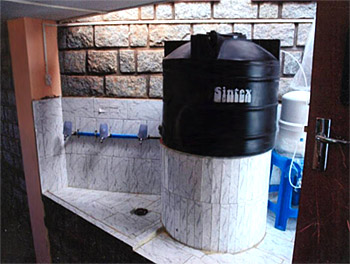 Vastu Shastra has laid down several principles for the placement of Overhead Water Tank in a flat or building. Vastu Shastra, as ancient science of architecture and construction, which dates back to the Vedic Period, suggests various guidelines and rules to attain success, happiness, prosperity in a household. Mental peace and spiritual bliss can be achieved through following Vastu. Overhead Water Tank is an important aspect in a house or building as it provides flowing water for drinking and other purposes. Thus the rules of Vastu should be followed while installing overhead water tank as it would bring knowledge, wealth and success.
Vastu Shastra has laid down several principles for the placement of Overhead Water Tank in a flat or building. Vastu Shastra, as ancient science of architecture and construction, which dates back to the Vedic Period, suggests various guidelines and rules to attain success, happiness, prosperity in a household. Mental peace and spiritual bliss can be achieved through following Vastu. Overhead Water Tank is an important aspect in a house or building as it provides flowing water for drinking and other purposes. Thus the rules of Vastu should be followed while installing overhead water tank as it would bring knowledge, wealth and success.
* The overhead water tank should be located in the west or the south-west direction of the building.
* The overhead water tank in this direction should be at least 2 feet above the topmost slab. The water tank should not touch the slab.
* The overhead water tank should not leak or seep water. Dampness and wetness in the south-west region is not considered auspicious in Vastu.
* The overhead water tank should not be placed in the north- east side, as this corner should not be heavy due to the weight of the tank. Although a small sized tank may be placed.
* Over head tank should not be located in the southeast corner also. If it is built here then it may lead to loss of wealth and accidents are probable.
* The effects of overhead tank in the south direction are moderate. The water tank should be placed 2 feet above the slab of the roof and it should not leak.
* The west corner is also considered auspicious in Vastu, as according to Hindu beliefs, this is the direction of god of rainfall, Lord Varuna. The overhead water tank can be installed on top of a slab.
* Overhead tank should not be in the north-west direction. If the water tank is constructed in this side due to lack of any other location, then the tank should be small sized and placed 2 feet away from the north-west corner.
* Care must be taken so that the tank is not built in the middle, which is considered as the Bramhasthan, as per Hindu beliefs. There should not be any sort of load of pressure in this location, as it can result unhappiness and other negative outcomes.
* Plastic water tanks should not be used and avoided as much as possible. But if plastic reservoirs are used, then it should be of black or blue colours. Moreover, separate tanks should be used for different purposes lik
e for drinking, toilets, washing, cooking etc.




















